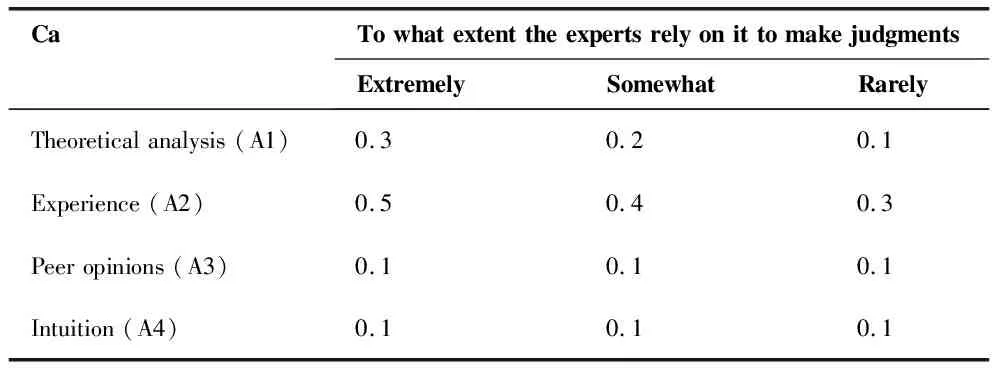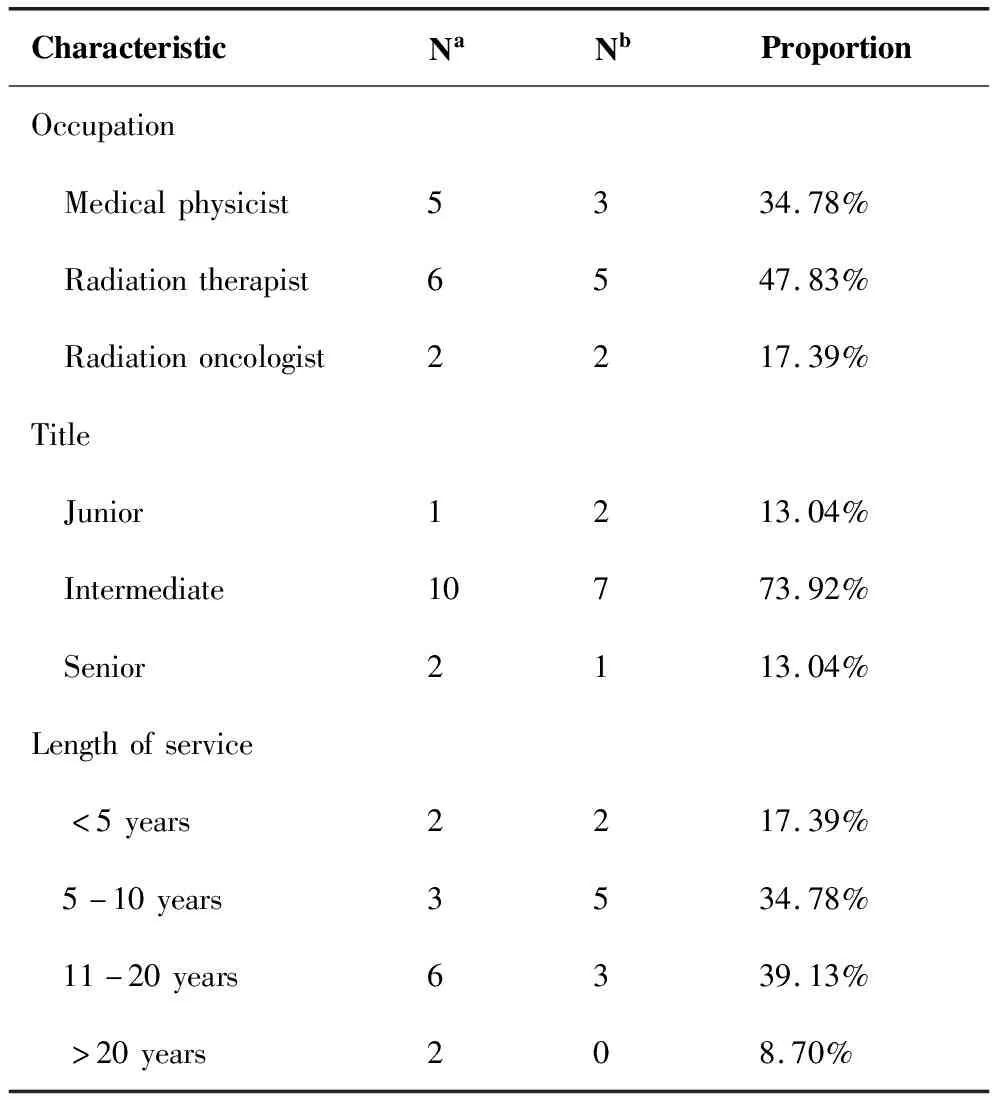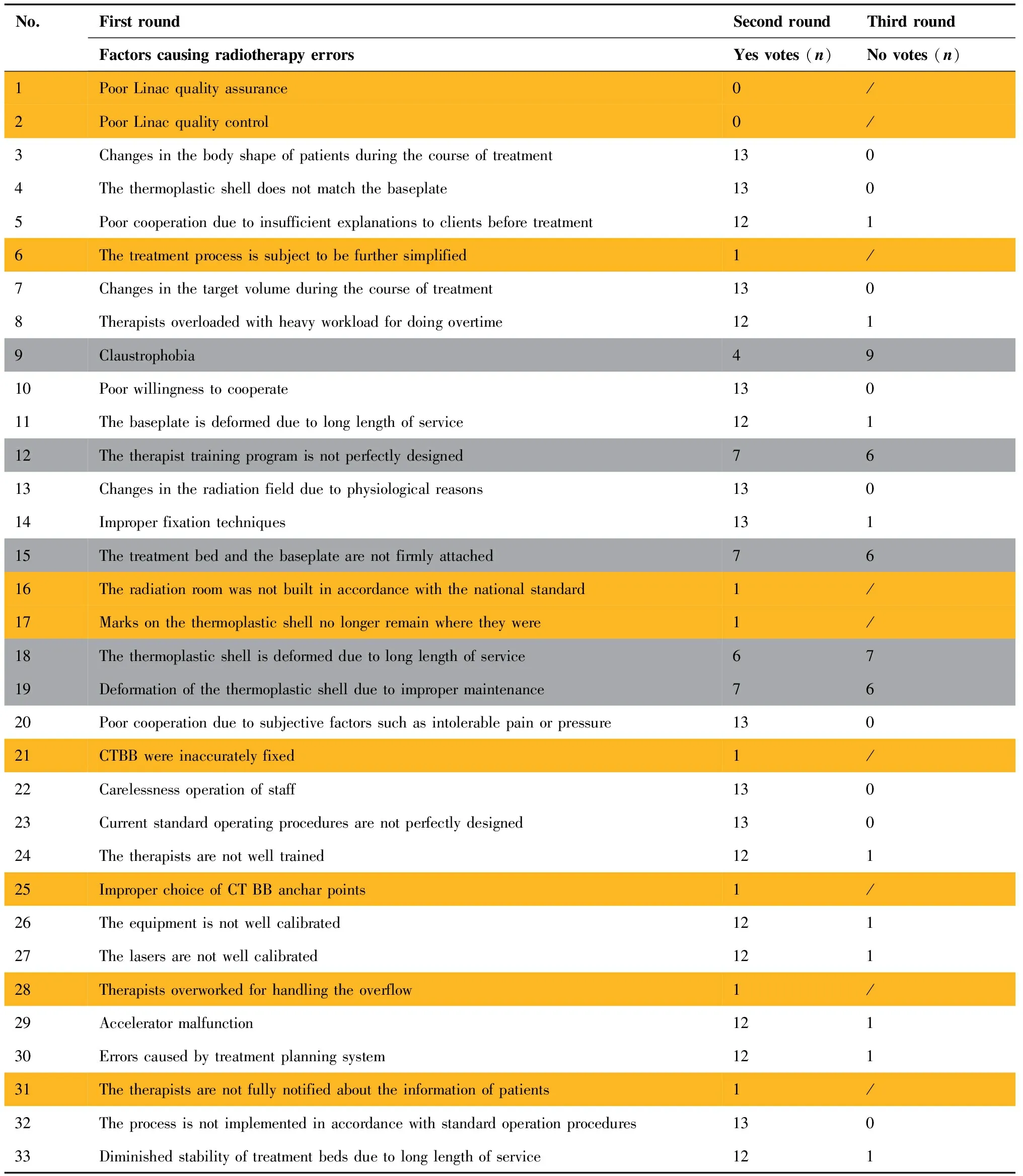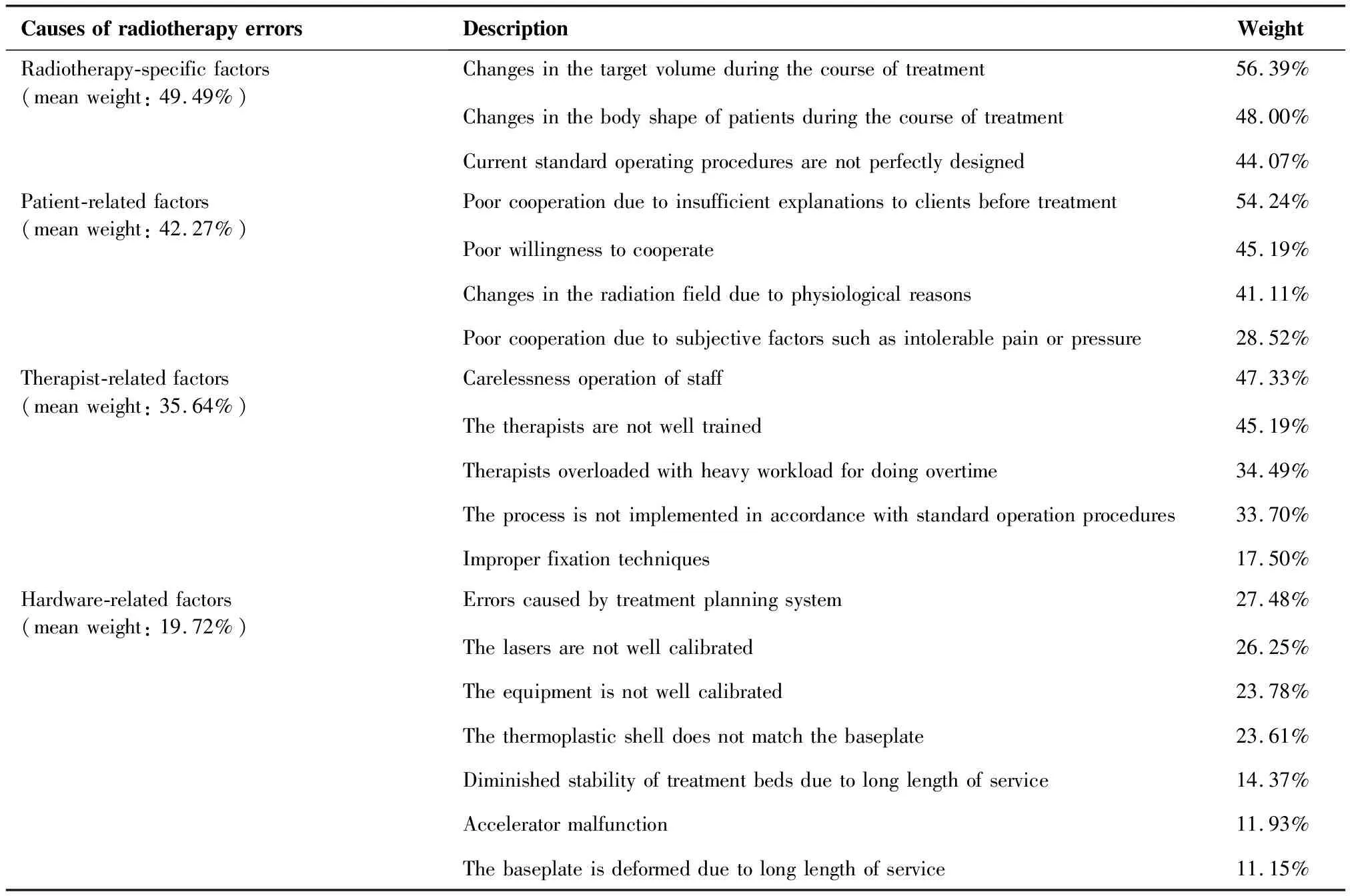Identification of Factors Influencing Radiotherapy Errors during Radiation Treatments Using Quality Management Tools
Li Lintao, Lucia Clara Orlandini, Wang Xianliang, Fan Ming, Lu Shun, Kang Shengwei, Zhang Dekang, Heng Li
Department of Radiation Oncology, Sichuan Cancer Hospital, Chengdu 610041, China(Li Lintao, Lucia Clara Orlandini, Wang Xianliang, Fan Ming, Lu Shun, Kang Shengwei, Zhang Dekang); Department of Radiation Oncology and Molecular Radiation Sciences, Johns Hopkins University School of Medicine, Baltimore, MD 21205, USA(Heng Li)
[Abstract] Objective:To investigate factors that may cause radiotherapy errors during radiation treatments using quality management tools.Methods: The Delphi method was used to sort out the factors that cause radiotherapy errors which were then classified by the Kaiser model.Results: In the first round of brainstorming, 33 types of influencing factors were put forward, which were further reduced to 19 through the Delphi method.The recruited factors were, then, divided into four types by the Kaiser model, radiotherapy-specific factors with the mean weight of 49.49%, patient-related factors with the mean weight of 42.27%, therapist-related factors with the mean weight of 35.64% and hardware-related factors with the mean weight of 19.72%.Conclusion: Delphi plus Kaiser may be a promising method for predicting factors that may cause radiotherapy errors, which is worthy of further research.
[Key words] Radiotherapy errors; Delphi method; Kaiser model; Radiotherapy
INTRODUCTION
Radiotherapy is one of the major treatment regimens for cancer[1], aiming to control tumors while preserving normal tissue as much as possible.A treatment for cancer patients is usually planned with a computed tomography image acquired at the very beginning of the treatment(the simulation phase), followed by a flow of complex processes[2].
The accuracy of dose delivery determines the success of radiotherapy.In this study, any error that may affect dose delivery accuracy during the course of radiotherapy was defined as a radiotherapy error.In the dose delivery phase, the position of the tumor must be precisely fixed where it was in the simulation phase, because the treatment plan has been prepared based on this perticular position.In order to achieve this goal, frequent imaging during a course of radiation treatment via image-guided radiation therapy(IGRT)is used to direct the treatment, position the patient, and compare to the pre-therapy imaging from the treatment plan, which helps reduce radiotherapy errors[3-4].However, there are still some errors that IGRT could not solve at current stage[5].Those errors may lead to treatment failures[6-8].Previous studies on radiotherapy errors by IGRT mainly focused on image modes or image registration[9], systematic methods whatsoever were rarely used.In order to probe into the key factors causing radiotherapy errors, the Delphi method and the Kaiser model were used in this study.
The Delphi method, an interactive forecasting method, is done in the form of an anonymous, written, multi-stage survey process, where feedback of group opinion is provided after each round[10].In Delphi studies, the participants usually do not know each other.Anonymity is guaranteed since the process is coordinated by a moderator.The Kaiser model, is originally a tool for hazard vulnerability analysis developed by Kaiser Permanente, an American integrated managed care consortium[11].The same way of weight assignment, as in the Kaiser model, was applied in our study for categorizing factors inducing radiotherapy errors.
In our study, the Delphi method was used to sort out the factors that cause radiotherapy errors which were then classified by the Kaiser model, thereby providing a novel way for recognizing and reducing radiotherapy errors.The radiotherapy practitioners, therefore, may have a clearer understanding of the error-influencing factors.
MATERIAL AND METHODS
We divided our study into two steps.First of all, we used the Delphi method to measure consensus.After 3 consecutive Delphi rounds, factors that may influence radiotherapy errors were gathered from experts who are anonymous to each other.We then used the Kaiser model to assign weightings to the judgments made by those experts, so that factors that primarily contribute to radiotherapy errors could be prioritized by radiotherapy practitioners.This study was completed by 23 experts on radiotherapy(including radiation oncologists, radiation physicists and radiation therapists from the radiotherapy center of Sichuan Cancer Hospital), in which 13 were responsible for the Delphi studies, while the other 10 for the Kaiser model.
The Delphi study
Our study consists of 3 rounds of written questionnaires that allow experts to give their opinions.In the first round, all respondents were encouraged to brainstormed a list of influencing factors of radiotherapy errors, and the judgments of the respondents were summarized by a facilitator and provided as feedback for the following round[10].In the second round, the facilitator handed out a summary report of the gathered factors to the respondents who were then asked to mark the factors they considered could lead to radiotherapy errors, and the factors with less than two votes were excluded.In the third round, the remaining factors were presented to the respondents who were asked to mark the factors that they considered had no effects on radiotherapy errors.The factors with more than two votes were excluded by the facilitator.
Recruitment of experts in the Delphi study
The Delphi method relies on experts who are knowledgeable about a particular topic.In our study, we recruited 13 experienced experts on radiotherapy, with an average age of 19.5 years(5-33 years).
Cr indicates how authoritative the experts are, which was the arithmetic mean of the sum of Ca(the criteria on which the experts based to make their judgments)and Cs(to what extent the experts are familiar with the questions analyzed).
① Cr=(Ca+Cs)/2;
② Ca=A1+A2+A3+A4;
A1 indicates theoretical analysis; A2 indicates experience; A3 indicates peer opinions; A4 indicates the experts’ intuition; and the weighting of each criterion are listed in Table 1.

Table 1. Criteria on Which the Experts Based to Make Their Judgments
The extent to which an expert was familiar with the questions analyzed were described by extremely familiar, moderately familiar, somewhat familiar, slightly familiar, not at all familiar.Weights assigned to the five response anchors were 0.9, 0.7, 0.5, 0.3 and 0.1, respectively.
The agreement among raters was measured by Kendall’s coefficient of concordance(a.k.a Kendall’s W)
The Kaiser model
When a consensus of forecasts was achieved after the Delphi method became complete, the facilitator in the Delphi study collected all the results and passed them on to another 10 experts also from the radiotherapy center of Sichuan Cancer Hospital.The experts were then invited to assign weights to events evaluated, and the mean values were recorded as results.The weighting(y in the Kaiser model)of a event can be obtained according to the following formula:

nrepresents the probability when an event occurs;prepresents the impact this event causes;wrepresents the attention this event attracts;sis a parameter indicating the external assistance needed to handle this event;p,wands, together, reflect the significance of this event.nmax,pmax, wmaxandsmaxare the maximum values ofn,p,wands, respectively.All the parameters in this formula spanned from 0 to 3.
RESULTS
Information of the panel members
The expert panel comprised radiotherapy experts of diverse occupations, titles and length of service.Information of the 23 experts recruited in this study was presented in Table 2.

Table 2. Composition of the Panel Members
The response rate of our Delphi-study
In the first round of brainstorming, we collected 33 factors that may lead to radiotherapy errors; in the second round, 9 factors less than 2 experts believe that will cause radiotherapy errors were excluded; in the third round, another 5 factors more than 2 experts believe that was the least important in affecting radiotherapy errors were excluded.As is shown in Table 3, 19 influencing factors that were agreed by all experts were generated after three Delphi rounds.The response rate(κ)was constantly 100% in three Delphi rounds.

Table 3. Factors Causing Radiotherapy Errors Predicted in the the Delphi Study
Reliability of our Delphi study
The Cr of our study was 0.8, with an average Ca of 0.7 and a Cs of 0.9, which could be considered as reliable, in that a Cr of 0.7 or higher is considered ‘a(chǎn)cceptable’ in most social science research situations.
Consistency(unanimity)of expert opinions
The Kendall coordination coefficient was 0.179 for the first round, and was 0.374 for the second round.ThePvalue of theχ2test in both two rounds are less than 0.001, signifying a high consistency in expert opinions which guarantees the reliability of our study.The factors exclusion rate was 27.3%.
Nineteen factors yielded by the Delphi method were introduced into the Kaiser model with which the weighting of each factor was assigned.The 19 factors were roughly divided into 4 categories, radiotherapy-specific factors with the mean weight of 49.49%, patient-related factors with the mean weight of 42.27%, therapist-related errors with the mean weight of 35.64% and hardware-related factors with the mean weight of 19.72%(Table 4).

Table 4. Results of Assignment by the Kaiser Model
DISCUSSION
The Delphi method has been widely and successfully used to aggregate expert opinions on future developments and incidents in the fields of science and technology including but not limited to the economy, education, healthcare, public policy and business situations.The application of Delphi method in medicine, first started in the research on nursing, and showed its superiority and application during use, has been favored by increasing number of researchers.The Kaiser model, however, is a hazard vulnerability analysis tool initially designed to identify hazards and effects these hazards may have on hospitals.We had found, via literature review, that the same way in which the weightings are assigned to the hazards on hospitals can be borrowed to assign weights for factors causing radiotherapy errors.This study, therefore, aimed to reach a consensus about the influencing factors leading to radiotherapy errors by using the Delphi method and analyze how significant those factors are by calculating their weightings using the Kaiser model.
After three rounds of Delphi study and further weight assignment by the Kaiser model, our study has categorized the factors which may cause radiotherapy errors into four types, radiotherapy-specific factors(mean weight: 49.49%), patient-related factors(mean weight: 42.27%), therapist-related errors(mean weight: 35.64%)and hardware-related factors(mean weight: 19.72%)as is shown in Table 4.
During the process of radiotherapy, some errors that worries radiotherapy practitioners the most are generated because of the characteristic of the therapy itself.For example, the foci tends to shrink as treatment schemes proceed.This target deformation is likely to trigger variation in the target volume if an adaptive treatment plan is not prepared.The treatment plan should be modified during a treatment course considering the target variation[12].Adaptive radiation therapy, therefore, has been applied in radiotherapy to solve real-time adjustment errors caused by tumor changes[13], with the weight of 56.39%.The change in body shape during radiotherapy is also an influencing factor with the weight of 48.0%.In conventional fractionation-based approaches, the treatment schedule usually lasts for more than 1 month[1,14-15].During radiotherapy, the patient often receives concurrent chemotherapy[16-18], which may cause a significant proportion of weight lost[19], eventually lead to treatment failure[20].Radiation therapy teams are required to pay attention to changes in the patient’s target volume and body during radiotherapy and respond in a timely manner.
Patient-related factors received 42.27% in weight assignment.Before the radiation treatment, the therapists need to give instructions to a client on how to position his or her body[21-22]to ensure that the patient is physically and psychologically prepared and cooperative.For example, patients need to take off their clothes before treatment, and they are also expected to maintain the same position as they did in the simulation, preserve radiation therapy markers by themselves, keep steady breathing and reduce movements during an entire course of treatment cycle[23], radiotherapy errors might otherwise occur[24-25].The implementation of specific radiotherapy techniques, such as deep inspiration breath hold or active breathing control, depends on patients’ full understanding and cooperation.A failure in instilling these precautions into patients may lead to radiotherapy errors(weight: 54.24%), and the insufficiency or ambiguity in information may further lead to unwillingness of patients to cooperate(weight: 45.19%).Physiological factors(weight: 41.11%)like breathing, bowel movements and pain also count.These factors have been confirmed to cause radiotherapy errors[26-27], and prevalent methods answering to that are breathing gating technology and enlargement of clinical target volume[28-29].Subjective feelings(weight: 28.52%)such as intolerable pain or pressure are reported to be the last culprit.Current studies have shown that patients tend to be anxious during radiotherapy[30], and pre-treatment education is convinced to be the remedy[31-32], but whether it is benificial to radiotherapy errors needs further confirmation.
A mean weight of 35.64% was assigned to therapist-related factors which include subjective reasons covering carelessness(weight: 47.33%), poor implementation of standard operation procedures(weight: 33.70%)and improper fixation techniques(weight: 17.50%), as well as objective reasons such as incompetent training of therapists(weight: 45.19%)and heavy workload(weight: 34.49%).Carelessness is considered to be the most likely cause of errors, which may lead to undesirable consequences such as the improper selection of the plan or patient during treatment[33].It is never too cautious to be an radiotherapy practitioner; and standard operating procedures should be unswervingly executed during the process of radiotherapy.
Thanks to the national quality assurance and quality control standard in radiology, all the experts in our study gave low weightings to hardware-related factors(mean weight: 19.72%).However, it doesn’t mean that this type of factors should be overlooked.Quality management should be further regulated in clinical practice as well.
In conclusion, we have probed into the value of the Delphi method and the Kaiser model as quality management tools in studying the factors influencing radiotherapy errors that worry experts on radiotherapy, some of which are barely noticeable though.Although the results in our preliminary exploration seems to be practicable and optimistic, there were still certain limitations while exploring the aim of the study.Other than inevitable technical convergence and cognitive bias, there were shortcomings during our application of the Delphi method in that the experts recruited are from the same institution because of restrictions on time and human resources, while the diversity should’ve been considered to reduce peer pressure.The feasibility of the combined use of the Delphi method and the Kaiser model in assessing either influencing factors of radiotherapy errors or other issues in radiotherapy is subject to confirmation by quantitative multi-center studies.

